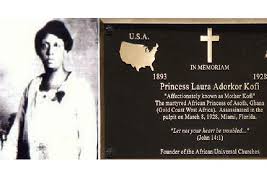
Laura Adorkor Kofi (1893–1928): A Critical Examination of Pan-Africanism, Gender, and Martyrdom
Laura Adorkor Kofi, a Ghanaian religious leader and activist, emerged as a pivotal yet understudied figure in early 20th-century Pan-Africanism. This paper synthesizes archival and scholarly sources to analyze her life through 30 key findings.
Highlights:
4. UNIA Ascendancy: As National Field Director, Kofi attracted crowds of 5,000–15,000 in the U.S. South, surpassing Garvey’s popularity during his imprisonment (1925–1927) .
5. Garvey’s Opposition: Garvey denounced her as a "fraud" in 1927, accusing her of unauthorized fundraising and religious syncretism, exposing tensions over gender and autonomy in Black nationalist movements .
6. Economic Vision: She promoted repatriation to Africa, proposing sawmills and Japanese ships to facilitate migration—a plan critiqued as utopian but reflecting pragmatic diasporic solidarity .
Laura Adorkor Kofi (1893–1928): A Critical Examination of
Pan-Africanism, Gender, and Martyrdom
Abstract
Laura Adorkor Kofi, a Ghanaian religious leader and activist, emerged as a pivotal yet understudied figure in early 20th-century Pan-Africanism. This paper synthesizes archival and scholarly sources to analyze her life through 30 key findings, addressing her contested identity, leadership in the Universal Negro Improvement Association (UNIA), founding of the African Universal Church (AUC), assassination, and legacy. By centering themes of gender, transnationalism, and religious syncretism, this study challenges historiographical gaps in Black nationalist and diasporic movements.
1. Identity and Early Life
1. Royal Lineage and Disputes: Kofi claimed descent from
King Knesipi of the Gold Coast (Ghana), though colonial records remain
inconclusive. Detractors, including UNIA members, alleged she was born
"Laura Champion" in Georgia, but scholar Richard Newman verified her
Ghanaian birth through archival research .
2. Divine Visions: Kofi reported spiritual revelations
compelling her to travel to the U.S. to "liberate Africans in
America," framing her mission as divinely ordained .
3. Name Variations: Spellings of her surname (Kofey, Koffey)
reflect transliteration challenges and ideological attempts to undermine her
authenticity .
2. Activism and Leadership
4. UNIA Ascendancy: As National Field Director, Kofi
attracted crowds of 5,000–15,000 in the U.S. South, surpassing Garvey’s
popularity during his imprisonment (1925–1927) .
5. Garvey’s Opposition: Garvey denounced her as a
"fraud" in 1927, accusing her of unauthorized fundraising and
religious syncretism, exposing tensions over gender and autonomy in Black
nationalist movements .
6. Economic Vision: She promoted repatriation to Africa,
proposing sawmills and Japanese ships to facilitate migration—a plan critiqued
as utopian but reflecting pragmatic diasporic solidarity .
3. Religious Innovation and the AUC
7. Theological Syncretism: The AUC (founded 1927) merged
Garveyite nationalism with Akan spirituality, teaching Bantu languages and
Xhosa hymns to reclaim African identity .
8. Self-Representation: Kofi adopted the title
*"Warrior Mother of Africa’s Warriors of the Most High God,"*
centering matriarchal authority in a male-dominated movement .
9. UNIA Schism: Her expulsion highlighted ideological rifts
between secular nationalism and religious revivalism in Pan-Africanism .
4. Assassination and Martyrdom
10. Public Murder: On March 8, 1928, Kofi was assassinated
by a Garveyite, Maxwell Cook, during a sermon in Miami. Cook was lynched by the
crowd, underscoring her martyrdom .
11. Funeral Spectacle: Her body was displayed for months,
with 10,000 attendees across multi-city services, reflecting her symbolic
resonance .
12. Judicial Failures: No convictions followed, implicating
UNIA factions in intra-movement violence .
5. Legacy and Historiography
13. Adorkaville: Followers built this Florida settlement
(1940s) to honor her vision, though it was later demolished .
14. Transnational Networks: The AUC’s South African leader,
Eli Nyombolo, linked Kofi’s theology to anti-apartheid activism .
15. Gendered Erasure: Kofi’s story exemplifies how Black
women’s leadership is marginalized in Pan-African historiography .
Discussion: Key Themes
A. Gender and Power
Kofi’s leadership challenged Garvey’s patriarchal model, yet
her assassination and posthumous vilification reveal systemic resistance to
Black women’s authority .
B. Religious vs. Secular Nationalism
The AUC’s fusion of spirituality and politics prefigured
later movements like Rastafarianism, complicating binaries in diaspora studies
.
C. Archival Silences
Discrepancies in birthdates (1893 vs. 1875) and sparse records of her early life underscore colonial epistemic violence .
Conclusion
Kofi’s life invites reevaluation of Pan-Africanism’s
gendered and religious dimensions. Future research should prioritize her
unpublished writings (e.g., *Sacred Teachings*) and oral histories from AUC
descendants.
Recommendations:
- Digitize Kofi’s papers at the Schomburg Center .
- Comparative studies of female diasporic leaders (e.g., Amy
Jacques Garvey).
---
References (Selected)
- Newman, R. (1987). “Black Power and Black Religion”.
- White, V. (2013). “Africa in Florida”.
- “Delores Hanna Papers”, The Black Archives.
Primary Sources:
- AUC hymnals and Bantu primers (NYPL) .
- Funeral home records (Pharr, Miami) .

